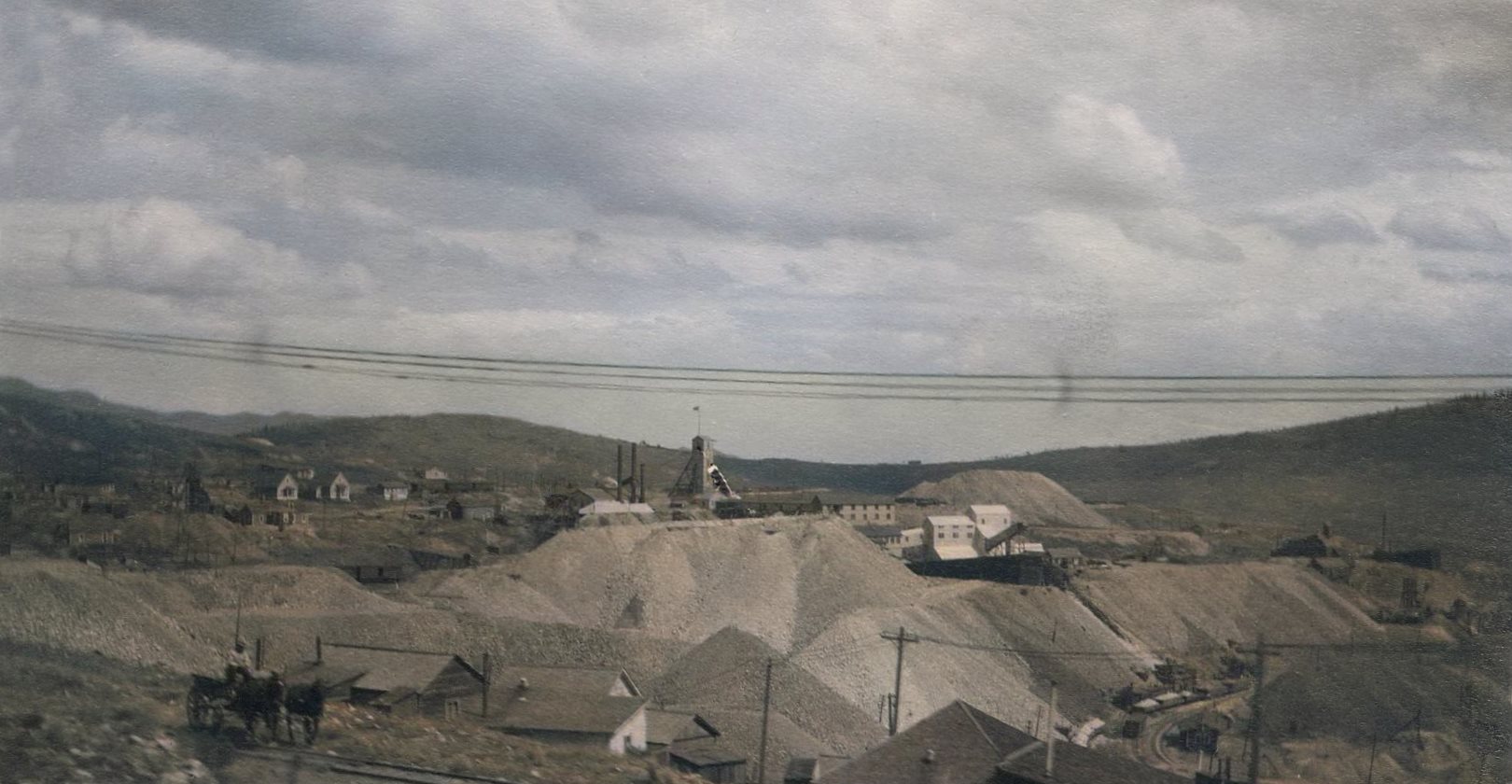-> HathiTrust Digital Library Site; Link to First Page.
I procured the coloring of the image, and fixed a typo in the text, + I added 1 extra image from my collection showing this mill structure!
The new crushing and screening mill of the Vindicator Consolidated Gold Mining Company in the Cripple Creek district was put in operation Oct. 15, 1914.
The object of the process employed is to increase the profit from the mine by treating the waste ore that formerly went to the dump. It is characteristic of many Cripple Creek ores that mechanical enrichment can be produced by simply crushing and screening, saving the finer and rejecting the coarser portions.
This affords a simple method of concentration that will yield profitable smelting products from otherwise waste rock. The ultimate profit per ton is not great, but amounts to a considerable sum on a large daily tonnage. The cost of a mill is small compared with that of a concentrating and cyaniding mill such as is adapted to Cripple Creek ores, and the process probably can be applied to ores of too low grade to be treated profitably by the more elaborate process.
The former practice at the Vindicator was to sort the mine ore, shipping the first-class product to smelters and washing the waste in order to recover fine rich mineral adhering to the surfaces of the rock. The extent of the sorting process and the quantity of ore rejected from run-of-mine product is indicated in the last annual report of the company, wherein it is shown that of 76,295 tons of crude ore hoisted, 26,343 tons of shipping ore was sorted, leaving roundly 50,000 tons of waste rock to be thrown on the dump.
The problem at the Vindicator was to devise a profitable method of treating this ore-house waste, for the simple expedient of washing the waste and recovering fine mineral was not wholly satisfactory. Accordingly experiments were begun in 1913, under the direction of Mr. Edward S. Wiard, of Denver, to see what improvement could be made.
Early tests indicated that the waste was capable of enrichment by crushing and screening. Experiments by jigging and tabling also showed good results, but not sufficiently high to warrant the consideration of such a process. The complete testing work involved many experiments in crushing, sorting, screening and washing, with separate assays of the various products.
From these tests data were obtained showing quantities and values, and affording a basis for intelligent design of a mill. The plant as finally built cost roundly $34,000, and is reported to be treating about 400 tons daily.
The flow-sheet of the mill is given in Fig. 1, and a view of the plant in Fig. 2. The ore-house stands at the left of the mill in Fig. 2, being connected herewith by a conveyor that delivers waste rock from the picking-belt in the ore-house to a large trommel screen in the mill.
The first section of the trommel screens out 3-in. rock and delivers it to the second-class ore bin. In the second section of the trommel the remaining rock receives a wash of water sprayed under 50 lb. pressure. The rich washings are delivered to settling tanks, and are shipped after drying.
The trommel oversize is delivered onto a sorting-belt from which first-class shipping ore is easily picked by hand after the washing it has received. Second-class ore also is sorted and combined with the trommel undersize. The final waste from sorting falls onto a cross conveyor and is discharged to the dump.
The second-class ore is then crushed to 1¼-in. size and elevated to dry trommels fitted with ⅛-in. screen. The undersize of these trommels is a shipping product, and the oversize is retained for a second crushing in rolls to ⅜-in. The roll product is then washed in a wet-trommel which serves merely as a scalping screen for the Bunker Hill 40-mesh screen which follows.
The wet-trommel oversize is discarded, but the undersize is further screened on a Bunker Hill screen of 40-mesh. the oversize of which also is discarded. The undersize is a shipping product and is delivered to a settling tank and then dried.
Thus the process comprises a preliminary wash, crushing in two stages with intermediate dry screening and final wet screening at ⅛-in., and 40-mesh, respectively. The values of the several concentrates are shown on the flow-sheet.
The arrangement of the plant is simple and convenient. The screens and picking-belt are placed in the top of the building, above bins and tanks which receive the various products. All of the waste rock rejected from the picking-belt and screens is delivered to a common conveyor leading to the dump.
The crusher and rolls are placed below their respective bins, and discharge their products onto conveyors leading to the two elevators that serve the dry and wet trommels.
The annual report of the company, dated Jan. 1, 1915, states that the new mill "has not been in operation at this time long enough to make any positive assertions, but the indications are that it will prove to be a very profitable investment."
Judging from the care taken in the preliminary tests, the mill should add to the general profit of the company.
p142crpd_fig2-vindicator-screening-mill-colored_i-03042.jpg)
p142crpd_fig1-flow-sheet-vindicator-screening-mill.png)
